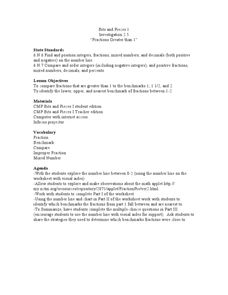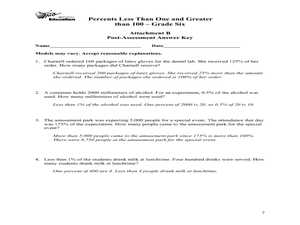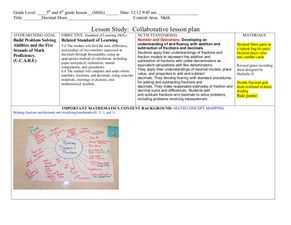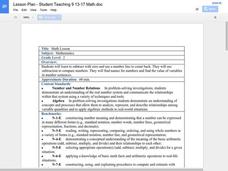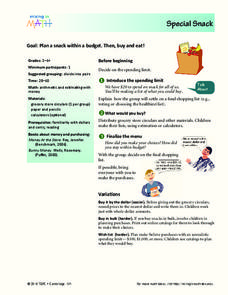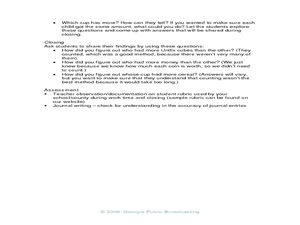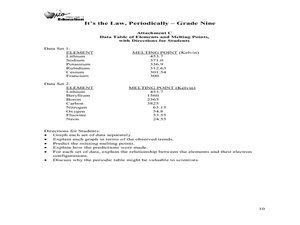Curated OER
Bits and Pieces: Fractions Greater Than One
Young scholars compare fractions. In this fraction worksheet, students examine the number line. Using the Internet, they explore models of numbers greater than one. Young scholars complete multiple-choice worksheets.
Curated OER
It Counts
Students explore one to one number correspondence. In this early math instructional activity, students make observations about and classify plants in order to gain an understanding of using numbers to describe their world.
Curated OER
What Makes Ten
Students investigate the concept of ten and how it is part of the real number system. They find the quantity of ten using as many combinations as possible. They can count using manipulatives, write on paper, or by doing mental math.
Curated OER
Percents Less Than One and Greater Than 100
Sixth graders express numbers as percents greater than 100 and less than one. In this lesson on percents, 6th graders work in groups with real life scenarios to develop an understanding on percentages greater than 100 and less than one....
Curated OER
Addition Properties
Student study addition properties. In this addition properties lesson plan, young scholars use multiple methods to solve various types of problems. Students illustrate and describe in various ways the Commutative Property of...
Curated OER
It Counts
Students explore how numbers can identify objects. In this math lesson, students determine how numbers are used to describe objects used in quantitative data collection.
Curated OER
Subtraction-There's Got to be An Easier Way!
Third graders observe and demonstrate a variety of problems involving subtraction problems using mental math strategies. They discuss the base ten system and the basic concept of subtraction, and complete a variety of activities...
Curated OER
Decimals: Collaborative Lesson
Pupils explore mathematics by participating in a group activity. In this number value lesson, students identify the uses for decimals and how to best estimate whole numbers based on decimals and fractions. Pupils collaborate with...
Curated OER
Buying in Bulk
Young scholars investigate buying purchases in bulk. In this buying in bulk lesson, students consider ways to cut costs and reduce waste in landfills by making bulk purchases.
Curated OER
More or Less Than
Students practice completing equations with the less than or more than symbol. They use index cards to create the equations. They compete with other groups to get the most correct.
Curated OER
Number Line Math
Second graders use a number line to practice subtraction. For this subtraction lesson, 2nd graders use a number line to count backwards. Students participate in mad math activities and solve problems.
Federal Reserve Bank
Less Than Zero
Perry the penguin wants to buy a new scooter, but he doesn't have any funds! Walk your kids through the short book Less Than Zero, and have them track his borrowing, spending, and saving on a line graph while you read. Pupils will learn...
Ohio Department of Education
Fraction and Decimal Equivalency
Mathematicians make representations of fractional parts of a whole and learn that a decimal is another way to represent a fractional part. Understanding is extended by comparing and ordering fractions and decimals on a number line. This...
Curated OER
Buggin' Out (Identifying and Adding Amounts of Money)
Students explore consumer math by participating in estimate exercises. In this currency lesson, students identify and define each piece of U.S. currency and their value to the monetary system. Students complete several money worksheets...
Curated OER
Fraction Conversion 2 (With Percents)
Fifth graders determine how to convert fractions, decimals, and percents. In this conversion lesson, 5th graders use an on-line applet to practice making these conversions. They review how to make the conversions in a whole class lesson...
Curated OER
Dividing by 4's
Third graders explore math functions by completing problem solving activities. In this division instructional activity, 3rd graders utilize the division strategies acquired earlier to divide multiple digit numbers by 4's. Students...
Curated OER
Special Snack
Students explore grocery store circulars to choose items for a snack. In this snack math instructional activity, students must plan a class snack for $20.00. Students create a list estimating costs. Students view lists and...
Curated OER
More! A Lesson on Comparing
Students practice counting and comparing objects. In this math lesson plan, students view a Count on It! episode. Students examine the value of what they are counting. Students estimate number in groups of items. ...
Curated OER
It's the Law: Periodically
Ninth graders examine the Periodic Table. In this element lesson, 9th graders observe the chemical reactivity of elements. They graph the properties and discuss the trend in the group and period of elements. The students use math to...
Ms. Amber Nakamura's Mathematics Website
Algebra Project
What would your dream house look like? A cottage? A medieval castle? High schoolers enrolled in Algebra design the perfect house while using slopes to write equations for various aspects of the project.
Curated OER
Taking Numbers Personally
Students are given a card with a number on it. They match up with other students holding a different representation of the same number. They create a simple story problem.
Curated OER
Earth Moon Scaling
A wonderful lesson incorporating math and physics skills along with specific details about the planetary bodies. The cross-curricular approach makes for a valid activity to challenge multiple ages and abilities. Your class could work in...
Curated OER
Comparing and Ordering Fractions
Learners practice ordering fractions. In this fractions lesson, students determine how to tell when a fraction is close to 1, 1/2 and other various fractions. Learners use benchmarks to order fractions.
Curated OER
Family Vacation
Students use math to plan a trip by houseboat down the Mississippi River. They research and obtain information on the Mississippi River and its surroundings and use multiple graphs to represent their data.
